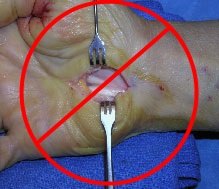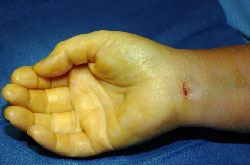Preventing and Ending Disability from Carpal Tunnel
Underlying Cause of Carpal Tunnel Syndrome
The underlying cause of carpal tunnel syndrome is generally a person's genetic heritage. Research has shown that most people with CTS are probably born with a small carpal tunnel and it gets tighter as they age due to wrist bone enlargement. The majority of patients treated for carpal tunnel syndrome have it on a familial basis. If the patient's mother or father is brought into the clinic they will, often times, admit to having had symptoms and treatment or those that haven't had treatment will most likely test positive for carpal tunnel syndrome through nerve conduction studies performed in the office.
Women tend to come in with carpal tunnel syndrome twice as often as men.
There is really no direct link between the development of carpal tunnel syndrome and one's occupation or duration of occupation. In fact, research has shown an inverse relationship between the duration of one's occupation and the development of carpal tunnel syndrome. This means that the longer one is on the job, the less likely they are to develop carpal tunnel syndrome. This is only based on one study by Peter Nathan, MD, in Portland but the take home on that study is that one anticipates that people not suited for certain jobs leave while those that are better suited for a given occupation stay on the job.
Temporary Disability
Temporary disability has been substantial and continues to be the main source of cost of carpal tunnel syndrome nationally. In general, time off of work is the greatest cost of all ailments being tied into the workplace by disillusioned employees. Nationally, carpal tunnel syndrome is the leading cost of disability payments, even more than low back pain! There has been a strong drive towards cost reduction in the treatment of carpal tunnel syndrome. At Nebraska Hand & Shoulder Institute, P.C., we do whatever is possible to get a person back on the job as quickly as possible and at the greatest capacity possible. With endoscopic carpal tunnel release, return to work after surgery is significantly faster with fewer complaints in recovery than patients who have undergone open (filet-of-wrist) carpal tunnel release. Part of this has to do with the fact that less tissue is damaged with the endoscopic carpal tunnel technique resulting in less discomfort. A patient doesn't feel as injured.
Open carpal tunnel release, in Dr. Ichtertz's opinion, is best called "filet-of-wrist." The differences in the recovery, between endoscopically treated and open carpal tunnel release patients, highlight this.

Open Carpal Tunnel Release, "Filet-of-Wrist". This surgery requires an extended period of recovery.

Endoscopic Carpal Tunnel Release. This image shows the minor incisions used with the scope procedure.
Classic studies comparing endoscopic vs. open carpal tunnel release have shown that patients prefer endoscopic over open carpal tunnel release. Nearly every study dealing with endoscopic carpal tunnel release has shown a marked improvement in return to work time over those patients seen after open carpal tunnel release. These studies, where return to work has been carefully scrutinized, reflect several weeks of time off for endoscopic carpal tunnel release vs. months for open carpal tunnel release. The studies indicating otherwise are very small, poorly controlled and performed in countries with socialized medicine and a low work ethic. Dr Ichtertz's patients usually return to work within 1 to 3 days, depending on their occupation.
In the United States, getting a patient to return to work for a problem treated under worker's compensation can be very difficult. Dr. Ichtertz's patients treated at the Carpal Tunnel Relief Center are usually back to work on modified or full duty within 24 hours. He uses a scientific protocol and provides the optimum amount of medication with the most effective anti-inflammatory to help prevent pain and non-addicting analgesic in the event of breakthrough pain if it occurs. Dr. Ichtertz provides a proprietary exercise regime. Rarely is a formal physical or occupational therapist needed. It is necessary to get the cooperation of a person's employer. While many jobs don't require specific restrictions, some jobs will have to be modified. The only absolute is that the patient must keep his/her wound clean for about a week in order for it to heal without a chance of infection. This has been accomplished with a very light dressing to keep the wound covered except for when showering. There has been no compromise in the results using this protocol. Wound management protocol needs to be followed to prevent infection. This includes washing with soap that kills bacteria the night before. A new chemical impregnated in a special Telfa pad was introduced recently and is sometimes used to further reduce bacterial count around the wounds. For most of Dr. Ichtertz's patients a bacteriocidal iodine solution (3M Duraprep) that has glue to make it adhere is used.
Misdiagnosis Delays Relief
On a national basis in the United States, the majority of upper extremity claims for worker's compensation benefits have come from carpal tunnel syndrome frequently misdiagnosed as tendinitis. Tendinitis is one of the most common misdiagnoses for carpal tunnel syndrome whether or not a person is trying to tie it into their job. Industrial clinics often don't offer a correct diagnosis and can't offer definitive treatment. When a person is diagnosed with tendinitis, the problem will be perpetuated by inappropriate pseudo-therapy in hope that the complaints will go away. The meat-packing industry in particular perpetuates the myth of tendinitis.
Compensation Neurosis
Psychological factors have a very large overall impact in a person's response to treatment and especially in the person's willingness to stay at work or return to work after any type of surgery. It doesn't matter whether it is a hernia repair or carpal tunnel release. People blaming their job for a problem are much more likely to complain more before and after surgery than a person who accepts the problem as their own with the need to get on with life. For the interested person, there is an excellent article written by Jane Derebery. Her term for this problem is "compensation neurosis."
Derebery, V. Jane, Tullis, William H. “Delayed Recovery in the Patient with a Work Compensable Injury.” (Journal of Occupational Medicine, Vol. 25, No. 11, November 1983, pp. 829-835.)



